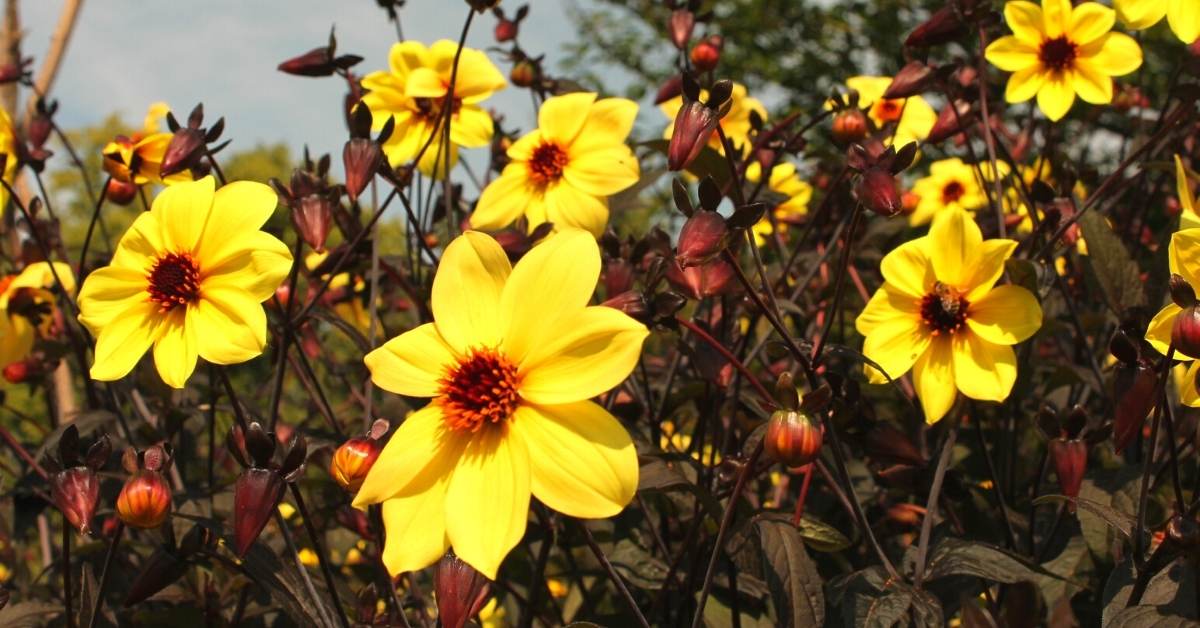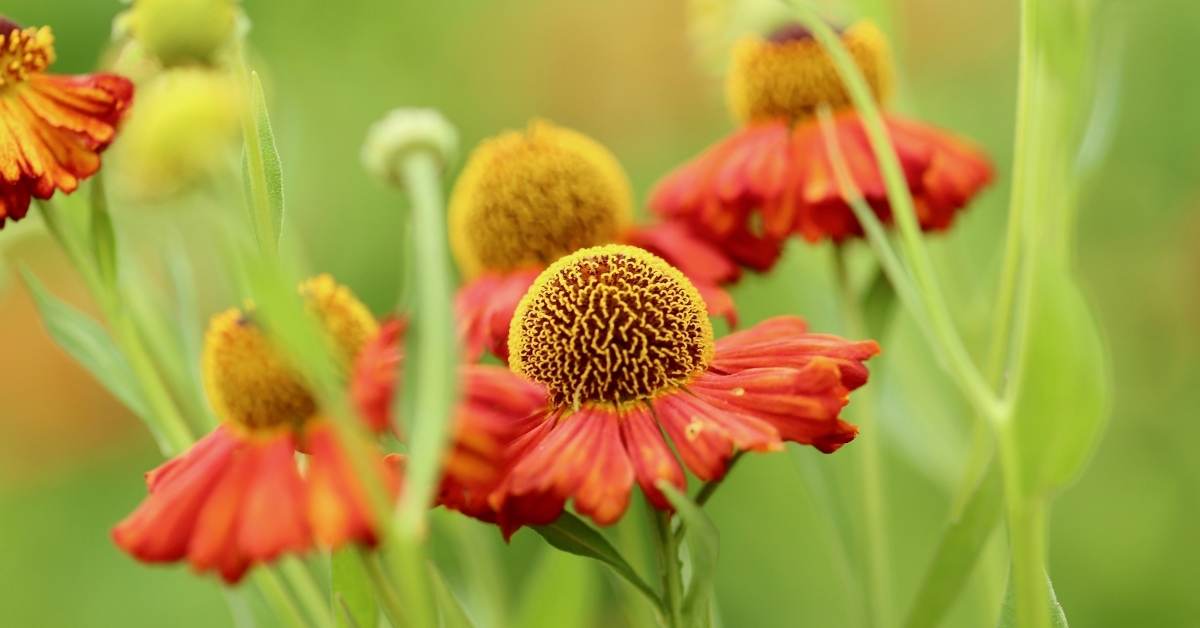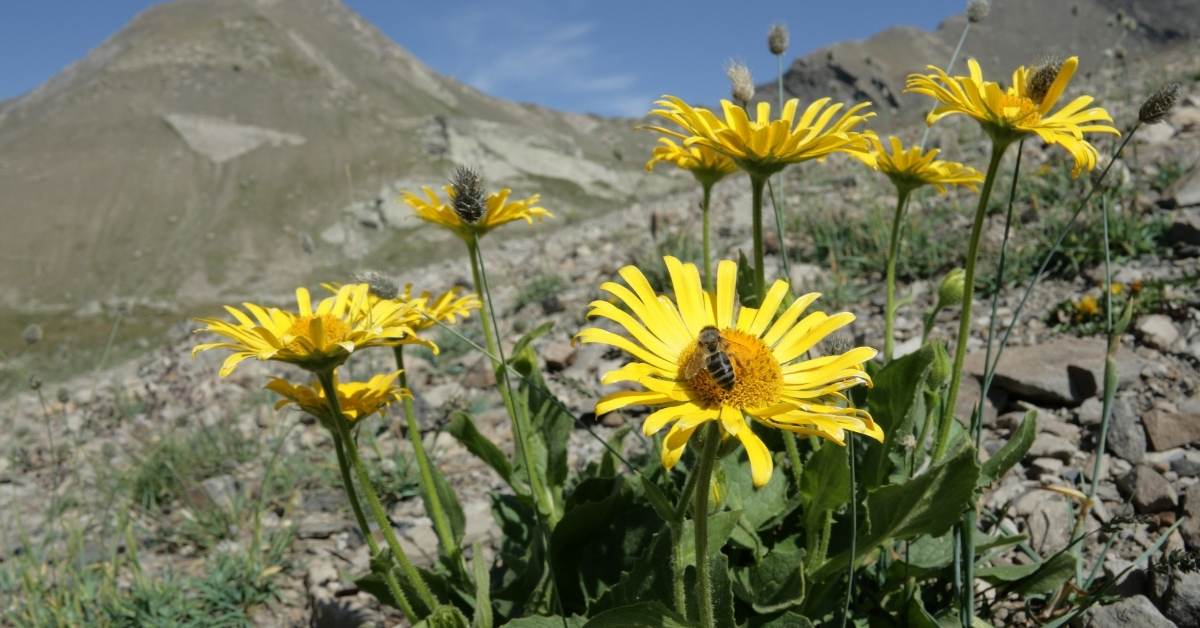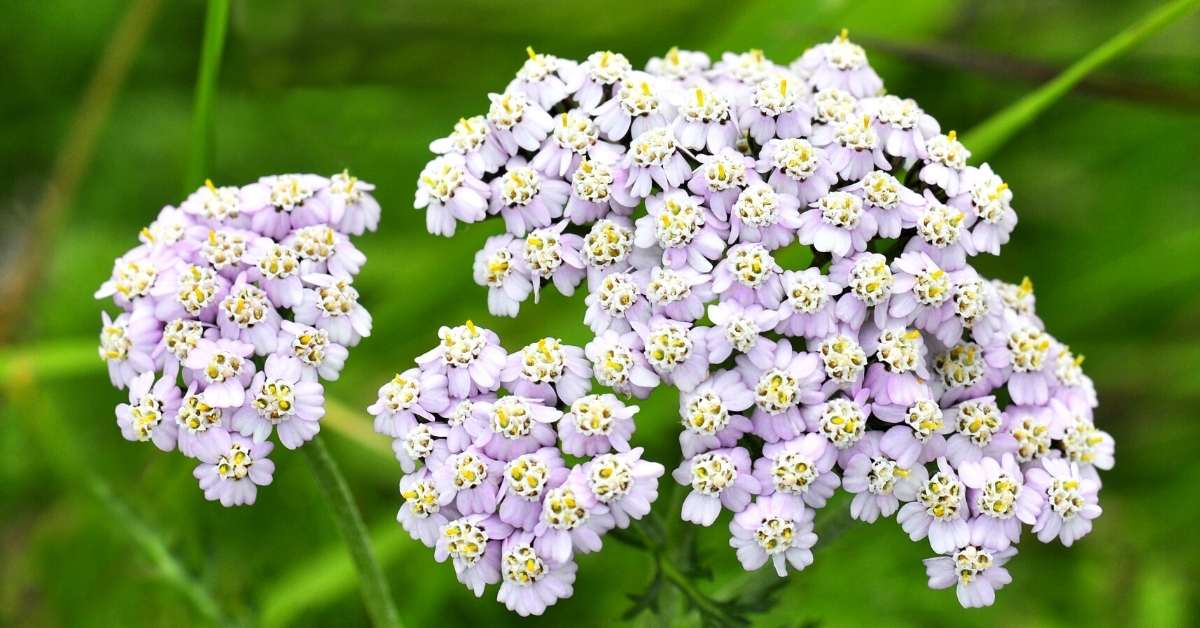Do you remember stories from your parents that started that way? You know the ones I mean. In the old days, we had to walk to school. Usually through blinding blizzards, flooded fields while fighting off vicious attacks from massed Fenian irregulars.
In the old days, we had to cut our meat from the living flanks of dinosaurs before they noticed. In the old days, things were tough; or at least a lot tougher than you soft young kids had it now. Dinosaurs, indeed.
In the old days, I would never consider growing Helenium or Sneezeweed in my garden. But then a nursery sent me a trial plant, and it has just bloomed. OK, so maybe it isn’t a dinosaur, and perhaps I have to take a good look at this family of plants because this Helenium ‘Chelsey’ daisy is very attractive with its burnt orange, crimson and yellow bi-colored petals and dark eye.
If you think the description of the petal color is a little “imprecise,” it is because the darn plant keeps changing the color, so poor garden writers can’t be precise.
Mind you, the gardener in me loves this because this makes ‘Chelsey’ an exciting garden addition rather than just something else to throw in the garden.
How to Grow Helenium (Sneezeweed) / Helenium Dancing Flames

The petals are non-drooping (in the old days, the petals used to droop), and the stems are thick and sturdy, so they don’t bend over like they used to. While Helenium autumnale is both the originating species and a North American native growing to 5 feet tall, the new varieties coming from Europe are only 30 inches tall and sturdy plants.
With a spread of twelve inches, Helenium ‘Chelsey’ is a restrained plant. At least it has been this year; we’ll see what it colonizes out to next year. It is going to be quite hardy as it is rated a USDA zone 4 and blooming starting now in July and running through August with those fantastic bright colors.
Yes, our native Sneezeweed has turned into a princess. This princess, though, still needs a few things done properly if you’re going to grow her well. She wants full sun, and although you might squeeze by with a bit of morning shade, it is really a good idea to give as much light as you like.
The key to success with Sneezeweed
The big key to success with Helenium or Sneezeweed is providing it with adequate moisture. This plant likes wet soils; no, this plant demands them if you want to succeed with it. It will not grow well with dry soils and tends to winterkill.
I know that these daisy-type plants often demand a few dry conditions to thrive, but this is not one of them. Give Helenium constant moisture, and it will love you and bloom accordingly. Give it rich, organic soil (think pond side here) with regular doses of water, and this plant is going to be a star performer.

You can also find Helenium varieties such as ‘Coppelia’ with yellow to bronze petals with chestnut brown center eyes.
‘Kanaria’ is pure yellow with broad grey-green leaves, and both of these varieties are 36 inches tall. ‘Moerheim Beauty’ has burned orange flowers that are attractive even as they fade, but it is listed as 48 inches tall.
Something a little on the weird side is ‘Autumn Lollipop’ that almost has no petals at all on the flower (they’re tiny) but looks like a big brown flower center that turns yellow when mature. ‘Bruno’ has deep crimson mahogany flowers on brown centers and is a 48-inch tall plant.
And if you like the old Helenium varieties, you might search out ‘Flammenspiel’ or ‘Dancing Flames’ (same plant) with its flame-orange blooms that age to yellow.
If you’re looking for a shorter Helenium, you might search out ‘The Bishop’ with its deep golden-yellow flowers, clumping growth, and earlier bloom time. It only grows 24 to 36 inches tall, depending on location and how much you feed it.
And finally, if you can find a Helenium ‘Chelsey,‘ I’m told that a part of the licensing fee (it is a patented plant) goes to the Red Cross Disaster Fund in memory of British journalist Terry Lloyd who was killed in Iraq. This is a great plant and a great reason to buy it. And that’s not in the old days.
Check out the video on how to grow Heleniums:
Some Other Significant Helenium varieties and specifications:
Helenium flexuosum (purple-headed sneezeweed)

Plant Details:
- Category: Helenium
- General information on Helenium flexuosum (purple sun bride)
- Botanical name: Helenium flexuosum
- Family: Asteraceae (Compositae)
- Family: asters
- Winter hardiness zone: Z4 -20 to -29 °F (-29 to -34 ° C)
- Plant group: perennials
- The habit of Helenium flexuosum (purple sun bride)
- Plant height: 12-14″ (80 to 90 cm)
- Growth habit: upright, leafy stems without a basal tuft of leaves
- Growth behavior: clumpy, loosely clumpy, clump-forming
- Sociability: I: If possible individually or small tuffs from 1-3- (5) to II: In small groups of 3-5- (10)
- Plant spacing: 24-31″ (60 to 80 cm); this corresponds to 2 to 3 plants per square meter.
- Flower and leaf of Helenium flexuosum (purple sun bride)
- Flower color: yellow
- Flowering period: July to September
- Flower shape: radial, radial symmetry
- Leaf color: deep green
- Leaf shape: lanceolate, rounded
- Leaf phase: deciduous
- Habitat (s) and soil of Helenium flexuosum (purple sun bride)
- Mainly: open spaces with wild shrub character on fresh to moist soil in sunny locations
- In addition: the edge of the wood on fresh to moist soil in sunny locations
- Soil structure: permeable
Other information on Helenium flexuosum (purple-headed sneezeweed)
Care instructions: cut back the stems from autumn to late autumn. Cut back withered inflorescences up to the upper stem leaves.
Helenium grandiflorum (Elecampane, Inula helenium, also called horse-heal or elfdock)

Plant Details:
- Category: Helenium
- General information on Helenium grandiflorum
- Botanical name: Helenium grandiflorum
- Family: Asteraceae (Compositae)
- Family: asters
- Winter hardiness zone: Z3 -31 to -38.2 °F (-35 to -39 ° C)
- Plant group: perennials
- The habit of Helenium grandiflorum (autumn sun bride)
- Plant height: 31-47″ (80 to 120 cm)
- Growth habit: upright, leafy stems without a basal tuft of leaves
- Growth behavior: clumpy, loosely clumpy, clump-forming
- Sociability: II: In small groups of 3-5- (10)
- Plant spacing: 24-31″ (60 to 80 cm); this corresponds to 2 to 3 plants per square meter.
- Helenium grandiflorum (autumn sun bride) flower and leaf
- Flower color: yellow
- Flowering period: August to October
- Flower shape: radial, radial symmetry
- Leaf color: deep green
- Leaf shape: lanceolate, rounded
- Leaf phase: deciduous
- Habitat (s) and soil of Helenium grandiflorum (autumn sun bride)
- Mainly: open spaces with wild shrub character on fresh to moist soil in sunny locations
- In addition: the edge of the wood on fresh to moist soil in sunny locations
- Soil structure: permeable
Other information on Helenium grandiflorum
Care instructions: cut back the stems from autumn to late autumn. Cut back withered inflorescences up to the upper stem leaves.
Helenium hoopesii (Sneezeweed Hoopesii, Orange sneezeweed)

- General information about Helenium hoopesii
- Botanical name: Helenium hoopesii (Orange sneezeweed)
- Family: Asteraceae (Compositae)
- Family: asters
- Winter hardiness zone: Z3 -31 to -38.2 °F (-35 to -39 ° C)
- Plant group: perennials
- The habit of Helenium hoopesii (early summer sun bride, Hoopes sun bride)
- Plant height: 24″ (60 cm)
- Growth habit: upright, leafy stems without a basal tuft of leaves
- Growth behavior: clumpy, loosely clumpy, clump-forming
- Sociability: II: In small groups of 3-5- (10)
- Plant spacing: 16″ (40cm) to 24″ (60 cm); this corresponds to 3 to 6 plants per square meter.
- Flower and leaf of Helenium hoopesii (Early Summer Sun Bride, Hoopes Sun Bride)
- Flower color: deep yellow
- Flowering period: May to June
- Flower shape: radial, radial symmetry
- Leaf color: deep green
- Leaf shape: tongue to spatula-shaped, rounded
- Leaf phase: deciduous
- Habitat (s) and soil of Helenium hoopesii (Early Summer Sun Bride, Hoopes Sun Bride)
- Mainly: open spaces with wild shrub character on dry to fresh soil in sunny locations
- Additionally: the edge of the wood on dry to the fresh ground in sunny locations
- Soil structure: permeable
Other information on Helenium hoopesii and Care instructions:
More or less high care expenditure, nutrient supply, and sometimes also plant protection measures.
Cut back the stems in autumn to late autumn. Cut back withered inflorescences up to the upper stem leaves.

